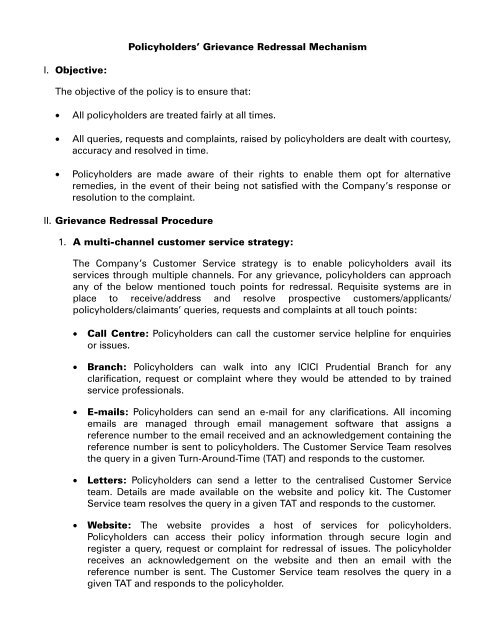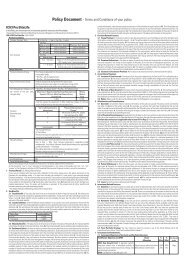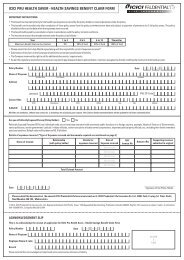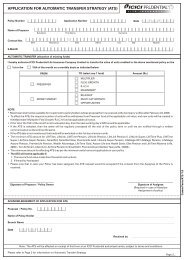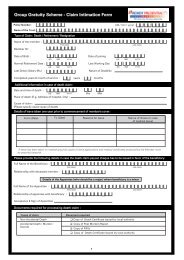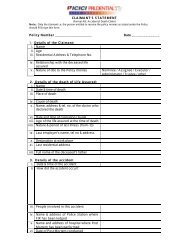Grievance Redressal Mechanism I. Objective - ICICI Prudential Life ...
Grievance Redressal Mechanism I. Objective - ICICI Prudential Life ...
Grievance Redressal Mechanism I. Objective - ICICI Prudential Life ...
Create successful ePaper yourself
Turn your PDF publications into a flip-book with our unique Google optimized e-Paper software.
Policyholders’ <strong>Grievance</strong> <strong>Redressal</strong> <strong>Mechanism</strong>I. <strong>Objective</strong>:The objective of the policy is to ensure that:• All policyholders are treated fairly at all times.• All queries, requests and complaints, raised by policyholders are dealt with courtesy,accuracy and resolved in time.• Policyholders are made aware of their rights to enable them opt for alternativeremedies, in the event of their being not satisfied with the Company’s response orresolution to the complaint.II. <strong>Grievance</strong> <strong>Redressal</strong> Procedure1. A multi-channel customer service strategy:The Company’s Customer Service strategy is to enable policyholders avail itsservices through multiple channels. For any grievance, policyholders can approachany of the below mentioned touch points for redressal. Requisite systems are inplace to receive/address and resolve prospective customers/applicants/policyholders/claimants’ queries, requests and complaints at all touch points:• Call Centre: Policyholders can call the customer service helpline for enquiriesor issues.• Branch: Policyholders can walk into any <strong>ICICI</strong> <strong>Prudential</strong> Branch for anyclarification, request or complaint where they would be attended to by trainedservice professionals.• E-mails: Policyholders can send an e-mail for any clarifications. All incomingemails are managed through email management software that assigns areference number to the email received and an acknowledgement containing thereference number is sent to policyholders. The Customer Service Team resolvesthe query in a given Turn-Around-Time (TAT) and responds to the customer.• Letters: Policyholders can send a letter to the centralised Customer Serviceteam. Details are made available on the website and policy kit. The CustomerService team resolves the query in a given TAT and responds to the customer.• Website: The website provides a host of services for policyholders.Policyholders can access their policy information through secure login andregister a query, request or complaint for redressal of issues. The policyholderreceives an acknowledgement on the website and then an email with thereference number is sent. The Customer Service team resolves the query in agiven TAT and responds to the policyholder.
2The Company Group clients can approach their respective relationship managerswith their query, request, critical request or grievances.2. Escalation <strong>Mechanism</strong>:The grievance redressal mechanism is further enhanced in line with the newguidelines as below:• <strong>Grievance</strong> <strong>Redressal</strong> Officer (GRO):If the policyholder is dissatisfied with the resolution provided by the servicechannels, he/she can escalate the issue to the local <strong>Grievance</strong> <strong>Redressal</strong> Officer(GRO) located at every office. They can write to the local GRO or register theircomplaint through the website.• Senior Management <strong>Grievance</strong> <strong>Redressal</strong> Officer:If the policyholder’s issue remains unresolved, he/she can escalate to thedesignated Senior Management <strong>Grievance</strong> <strong>Redressal</strong> Officer. They can write tothem or register their complaint through the website.• <strong>Grievance</strong> <strong>Redressal</strong> Committee (GRC):If the policyholder still remains dissatisfied with the resolution, he can furtherescalate the matter to the GRC. The GRC is chaired by an independent memberand consists of two independent members & heads of related departments.Policyholders can write to them or post their complaint through the website.• Insurance Ombudsman:If the policyholder is still not satisfied with the response or resolution provided bythe Company, he/she can write to Insurance Ombudsman. The detailedaddresses and contact details of the Insurance Ombudsman, set up acrossvarious locations in the country, are provided to the policyholders in their policydocument and are also made available on the website.3. Service delivery standardsCompany has defined its ‘service delivery standards’ for its core service deliveryprocesses in line with the regulatory guidelines. This would be communicated topolicyholders post policy issuance and at appropriate intervals. This would beprovide as a base to categorise a customer interaction as query, request, criticalrequest or grievance.4. Categorisation on customer interaction:2
3• Query: Policyholder/Applicant/Prospect contacts the Company primarily forinformation about the policy and/or its services and/or follows up on a status of aparticular request within the stipulated regulatory time framee.g. Information related to premium due, value of fund, claim procedure, followup on status of policy within regulator timeframe (Currently 15 days)• Requests: Communication received from a Policyholder/Applicant/Prospectsoliciting a service such as a change or modification in the policy/requests forstatemente.g. request for a duplicate renewal premium receipt, request for unit statement,change in nomination, increase in sum assured, etc.• <strong>Grievance</strong>s: A <strong>Grievance</strong> is defined as any communication that expresses dissatisfactionabout an action or lack of action, about the standard of service/deficiency of service of an Insurance Company and/or any intermediary or asksfor remedial actionTo categorise any interaction as ‘grievance’, the benchmark would be ‘Service’as defined in the Company’s ‘Service delivery standards’ document which are inline with the regulatory guidelines.The following shall be considered as grievances:• Any lapse in service. Service as defined in the Company’s ‘Service deliverystandards’ document which are in line with regulatory guidelines.• Complaints received from IGMS/IRDA• Complaint arising due to lack of action from previous request/critical request.While offering a resolution on the ‘grievance’ to the Customer, Company shallinform the complainant about the <strong>Grievance</strong> <strong>Redressal</strong> <strong>Mechanism</strong> on howhe/she may pursue the complaint, if dissatisfied.In case the customer walks – in at the branch, he/she would need to provide awritten complaint.• Critical Requests: Transactions expected from the Company have been fulfilledas per regulatory guidelines and in line with the Company’s ‘Service deliverystandards’ however the Customer does not acknowledge the same. These caseswould be categorised as “Critical Requests” for re-execution of thetransaction/request. This segment would be tracked for continuousimprovement of processes.e.g. Follow up on policy kit where dispatch details are available
45. Classification of customer interactionAll Complaints/<strong>Grievance</strong>s will be classified in accordance with the guidelinesprovided by the Authority. A user friendly classification scheme is introducedcovering all the categories prescribed by the guidelines. The TAT for eachclassification is also formalized as per the guidelines provided by the Authority.6. ProcedureRecording and tracking of interactions:• All interactions are captured in a centralised Customer Relationship Management(CRM) system.• A unique reference number is generated for every interaction.• Basis the categorisation and classification, system will populate pre-definedTATs.• The new grievance definition has been implemented since August 11, 2010.Acknowledgment:In case a grievance cannot be resolved within 3 business days, a writtenacknowledgment will be sent to the Customer. For grievances reported via CallCentre or email channel, an email acknowledgement will be sent wherever aregistered email id is available. In case email id is not registered a letter would besent at the registered mailing address. For branch walk-ins the customer would beoffered an acknowledgement on the spot. An auto acknowledgement by ‘SMS’ willbe sent to policyholders post registration of grievance with “Company Name” signoff wherever a registered mobile number is available.The written acknowledgement shall contain the following:• Name and Designation of the officer who will deal with the grievance• <strong>Grievance</strong> <strong>Redressal</strong> Procedure• Turn Around Time to resolve the complaintTime frame for response:• The TAT for resolving grievance redressal would be as defined in the guidelinesfor grievance redressal by the Regulator.• TAT: Within 2 weeks of registering grievance to a final resolutionletter/communication sent.• In the event of failure to comply with aforesaid timelines, the customer shall beinformed of the reasons and the revised timeline for resolution.• Internally, the TATs laid down by the Authority are adopted and mechanisms areput in place to ensure adherence to the TATs assigned to each category.4
5Status of complaints:All touch points are empowered to provide status of complaints/grievance topolicyholders. The Company shall also enable its systems to facilitate tracking ofstatus of grievances by complainants.Complaint resolution:• The Company shall send the Customer a written response which offers redressalof the grievance or rejects the complaint justifying the same.• Where the Company has resolved the complaint within 3 business days, theacknowledgement will be sent as part of the resolution communication whichshall contain the name and designation of the officer who has dealt with thegrievance.• Customer shall be informed on how to pursue the complaint by making availablethe <strong>Grievance</strong> <strong>Redressal</strong> Procedure in case he/she is dissatisfied with theresolution along with timeframe (8 weeks) to respond in case of disagreement.• Closures have been clearly defined and documented for all processes internallyand sample cases are audited by the Service Quality team to check Quality ofClosure.• All offices of the Company shall follow the above grievance redressal procedure.Complaint re-opening:Post receiving the resolution if the customer approaches the Company within 8weeks or before grievance disposal, the original ‘grievance’ interaction will bereopened.• The grievance representation will be reviewed thoroughly. The officer will assesscustomer’s feedback along with the basis of the stand taken by the Companywhile resolving the grievance.• Post reviewing the facts, suitable resolution will be provided to Customer within10 days.Closure/disposal of complaint:Complaint will be considered as closed if any of the below mentioned scenarios aremet:• Company has acceded to the request of the complainant fully• Complainant has indicated in writing, acceptance of the response of the insurer• If no reply is received from the customer within 8 weeks of response then thecomplaint will be auto disposed as per the disposal guidelines laid down by theAuthority.• GRO has certified that the Company has discharged its contractual, statutory andregulatory obligations
67. System requirementsCustomer has the facility to log a grievance online and track the status of hisgrievance through any of the Company’s touchpoints.The Company’s CRM systems are compliant with IRDA’s Integrated <strong>Grievance</strong>Management System (IGMS) effective May 6, 20118. Publicising <strong>Grievance</strong> <strong>Redressal</strong> procedureThe <strong>Grievance</strong> <strong>Redressal</strong> procedure is published on the website in accordance withthe Authority’s guidelines.9. Enabling front line teams (Training)The Company has defined regular training interventions to develop soft skills,process knowledge and understanding of regulatory requirements for the front linecustomer service executives.A segmented approach is followed for devising a training plan on the basis ofvintage and seniority of the employee. Company ensures that the teams attend thegrievance module once in six months.Training programs to enhance knowledge on regulatory and process related topolicyholders’ protection is provided by the Company through face to face trainingsor e-learning modules.10. Process improvementsThe complaints would essentially provide valuable insight into areas of improvementwithin the Company’s internal processes and procedures (including automatedprocesses) that impact the Company’s ability to conduct its business efficiently andsuccessfully.The grievances/complaints received shall be analysed to:• Identify and extract issues that concern the customer.• Map processes of handling the issue, determine if the current process isfollowed optimally.• Identify root cause of complaints and erring units, if any.• Initiate process changes, if required.• Track the impact of process changes.The Company submits a detailed Root Cause Analysis report to IRDA on Quarterlybasis.6
7III. Forums to review customer grievances, redressal mechanisms and enhancethe quality of customer service:• Customer Council:Customer Council is an executive level Council chaired by the Managing Directorand comprises of representatives from marketing, sales, products, compliance,operations and customer service departments. The Council intends to meet at leastonce in a month or as may be required from time to time. The Council periodicallyreviews service performance measures, major operational changes or any otherissue impacting customer service delivery. A quarterly report on its performance issubmitted to the Board Customer Service & Policyholders Protection Committee(CSPPC)• <strong>Grievance</strong> <strong>Redressal</strong> Committee (GRC):<strong>Grievance</strong> <strong>Redressal</strong> Committee is chaired by an eminent independent member. TheCommittee has one more independent member, in addition to the Chair. Heads ofrelated departments are members of the Committee. The Committee focuses onbuilding and strengthening customer service orientation in the Company by initiatingvarious measures including simplifying processes for improvement in customerservice levels. The Committee holds quarterly review meetings to discuss serviceupdates, ongoing projects specifically targeted towards improvement of customerservice and appropriate actions arising from discussions. The GRC carries out thefollowing specific functions:a) Evaluate feedback on quality of customer service received from variousquartersb) Ensure that the Company follows all regulatory requirements regardingcustomer service and actionables as suggested by the Customer Service &Policyholders Protection Committee (CSPPC)c) Submit report on its performance to the CSPPC on a quarterly basis.
8• Customer Service & Policyholder Protection Committee of the Board:In order to address the various compliance requirements relating to the protection ofthe interests of policyholders, to keep the policyholders educated about insuranceproducts and complaint-handling procedures and to continually monitor the qualityof customer service, the Company in accordance with clause 7.5 of the CorporateGovernance Guidelines dated August 5, 2009 issued by the Authority, constituted a‘Customer Service and Policyholders Protection Committee’ which shall directlyreport to the Board of Directors.The Committee will ensure existence of systems which provide policyholders anaccess to redressal mechanism. It shall establish policies and procedures, for thecreation of a dedicated unit to deal with customer complaints and resolve disputesexpeditiously. Thus, the responsibilities of the Committee shall include:a) Putting in place proper procedures and effective mechanism to addresscomplaints and grievances of policyholders including mis-selling byintermediaries.b) Ensure compliance with the statutory requirements as laid down in theregulatory framework.c) Review of the mechanism at periodic intervals.d) Ensure adequacy of disclosure of “material information” to the policyholders.These disclosures shall, for the present, comply with the requirements laid downby the Authority both at the point of sale and at periodic intervals.e) Review the status of complaints at periodic intervals to the policyholders.f) Provide the details of grievances at periodic intervals in such formats as may beprescribed by the Authority.g) Provide details of insurance ombudsmen to the policyholders.h) Reviews the functioning of the Standing Committee on Customer Service (GRC)i) Shape the Customer Service Philosophy and policies of the organization basedon the overall environment in the financial services industryj) Oversee the functions of the Customer Service Councilk) Review measures for enhancing the quality of customer servicel) Provide guidance to bring about improvement in the overall satisfaction level ofpolicyholders8


